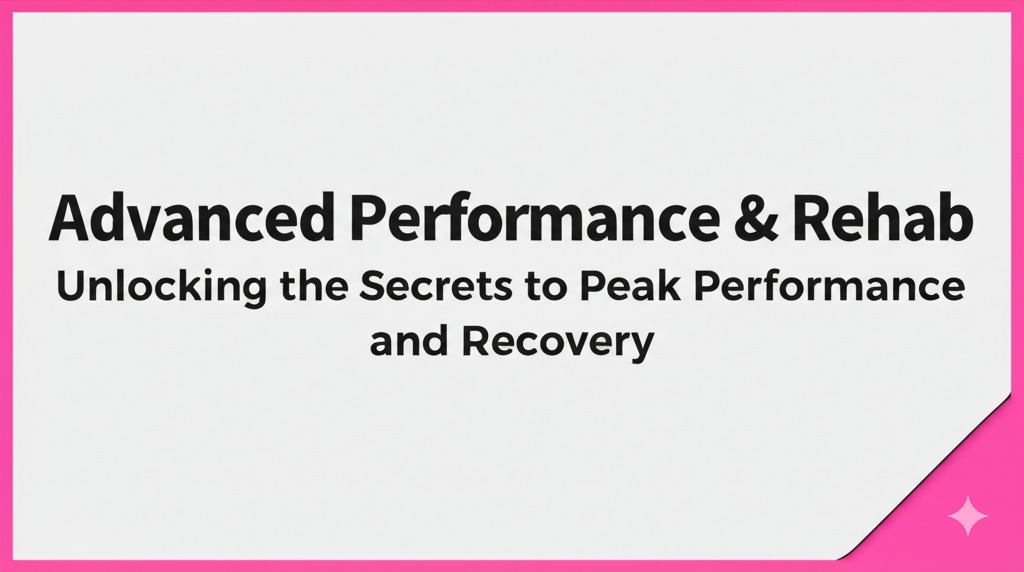Introduction
In the world of sports, fitness, and rehabilitation, the pursuit of peak performance and a swift recovery is paramount. Whether you’re an athlete pushing the boundaries of your capabilities or someone recovering from an injury, advanced performance techniques and rehab strategies play a crucial role in achieving your goals. But how do you optimize both performance and recovery? What are the cutting-edge approaches that professionals use to reach new heights while minimizing the risk of setbacks? This article dives into the advanced methods that are revolutionizing performance enhancement and rehabilitation, combining science, technology, and personalized care to help individuals perform at their best and recover efficiently.
The Evolution of Performance and Rehab Techniques
From Traditional Methods to Advanced Approaches
The field of performance and rehabilitation has come a long way. In the past, recovery was primarily about rest, ice, and simple stretching. However, as our understanding of human biomechanics, physiology, and recovery has advanced, so have the methods used to boost performance and facilitate quicker recovery.
Today, professionals utilize a variety of innovative techniques that blend both science and practical application. From neuromuscular activation to advanced biomechanics, these techniques focus not only on recovery but also on improving an individual’s physical capabilities to prevent future injuries.
The Importance of a Holistic Approach
Advanced rehab strategies don’t just focus on the injury itself. They take a holistic approach, addressing the entire body, mind, and lifestyle to ensure full recovery and optimize performance. This approach includes nutrition, mental health, biomechanics, sleep, and stress management.
Key Components of Advanced Performance & Rehab
1. Neuromuscular Activation: Building Strength from the Inside Out
Neuromuscular activation (NMA) involves the stimulation of specific muscles and nerves to improve movement patterns and muscle recruitment. By incorporating NMA techniques into performance and rehab routines, athletes can target weak or underactive muscles that may contribute to inefficiencies or injuries.
- Example: For a runner with weak glutes, activating these muscles before training can improve running form and reduce strain on other body parts like the knees and lower back.
- Techniques Used: Electrical stimulation, resistance training, and proprioceptive neuromuscular facilitation (PNF).
2. Advanced Mobility and Flexibility Techniques
Mobility is critical for improving performance and preventing injuries. Advanced techniques like dynamic stretching, active release therapy, and fascial stretching are gaining popularity in rehabilitation programs.
- Dynamic Stretching: This form of stretching involves active movements that improve flexibility and joint range of motion. It’s commonly used in warm-up routines to prepare the body for intense activity.
- Active Release Therapy: This soft-tissue treatment helps to break down scar tissue and adhesions in muscles and fascia, allowing for improved mobility and pain relief.
Improved mobility means greater freedom of movement, increased strength potential, and less likelihood of injury.
3. Biomechanical Assessment and Movement Correction
Advanced performance programs often incorporate biomechanical assessments to identify movement deficiencies that may lead to performance setbacks or injuries. This can involve the analysis of gait, posture, and movement patterns using video analysis, force plates, or wearable sensors.
By understanding your biomechanics, a rehabilitation professional can suggest corrective exercises to fix improper movement patterns, improving both performance and overall health. A proper assessment can catch subtle issues before they lead to more significant problems.
4. Cryotherapy and Heat Therapy: Speeding Up Recovery
Cryotherapy, the use of cold therapy, and heat therapy are both staples in the recovery process for elite athletes. These therapies help reduce inflammation, enhance circulation, and promote faster healing.
- Cryotherapy: Involves exposing the body to extreme cold (like ice baths or whole-body cryotherapy chambers) to reduce muscle soreness and inflammation.
- Heat Therapy: Helps to improve blood flow, loosen tight muscles, and relax the body, especially post-injury.
These therapies, when used correctly, help manage pain and discomfort, speeding up recovery times.
5. Nutrition and Supplements for Optimal Performance
Proper nutrition is often the most overlooked aspect of performance and rehabilitation. Whether you’re in the midst of rehab or looking to enhance your performance, nutritional strategies can have a profound impact on your progress.
- Anti-inflammatory foods: Foods rich in omega-3s, antioxidants, and vitamins play a role in reducing inflammation and aiding tissue repair.
- Protein and Recovery: Consuming protein immediately after exercise aids muscle recovery and growth, while maintaining proper hydration ensures that your muscles are primed for performance.
Supplements such as collagen, creatine, and branch chain amino acids (BCAAs) can further support muscle recovery and prevent muscle breakdown during intense training.
The Role of Technology in Advanced Rehab and Performance
1. Wearable Technology
Wearables like fitness trackers, smartwatches, and motion-capture devices are becoming increasingly important in both performance and rehabilitation. These devices help track an athlete’s movement, monitor heart rate, and measure stress levels in real-time, allowing for more personalized treatment.
For example, a smart compression sleeve can help track muscle fatigue and provide biofeedback to inform an athlete’s recovery needs. Real-time data is crucial for making adjustments to training programs to ensure optimal performance.
2. Virtual Reality (VR) for Rehab
One of the most cutting-edge advancements in rehab is the use of virtual reality (VR). In rehabilitation settings, VR can be used to help patients recover mobility after surgery or injury. It simulates real-life movements in a controlled environment, making rehab both interactive and engaging.
Conclusion
The combination of advanced performance techniques and rehab strategies has revolutionized the way we approach physical health and fitness. From neuromuscular activation to cutting-edge technologies like VR and wearable devices, athletes and individuals in recovery now have access to more tools than ever to maximize their potential.
By incorporating a holistic approach that includes nutrition, biomechanics, mobility techniques, and the latest recovery modalities, anyone can improve their performance and recover efficiently. If you’re ready to elevate your performance or speed up your recovery, it’s time to explore these advanced strategies and integrate them into your routine.

Kallie Snyder is an author at Stonegate Health Rehab, providing valuable insights, recovery guidance, and rehab resources to help individuals achieve better health and well-being.
